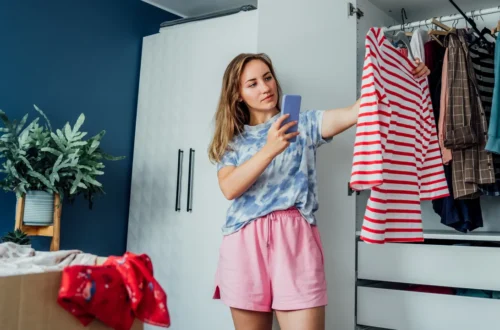Fashion isn’t just about looking good—it’s about feeling good, too. Mindful fashion blends style with self-care, encouraging us to make intentional choices that reflect who we are and what we value. It’s about curating a wardrobe that sparks joy, respects the planet, and nurtures our mental well-being. Let’s explore how this movement is reshaping the way we dress and live.
What Is Mindful Fashion?
Mindful fashion is the practice of choosing clothing with intention, prioritizing quality, sustainability, and personal connection over fleeting trends. It’s about building a wardrobe that aligns with your values—whether that’s eco-consciousness, ethical production, or simply wearing what makes you feel like your best self. This approach transforms fashion into an act of self-care, where every outfit becomes a small celebration of who you are. By focusing on mindfulness, you’re not just dressing your body; you’re honoring your mind and soul.
Why Mindfulness Matters in Fashion
Mindfulness in fashion means pausing to consider the “why” behind your clothing choices. Are you buying that dress because it’s trendy or because it truly resonates with you? This shift in perspective helps you avoid impulsive purchases and fosters a deeper connection with your wardrobe. It’s like meditation for your closet—calm, deliberate, and grounding.
The Self-Care Connection
Clothing can be a powerful tool for self-care. Getting dressed mindfully can boost your mood, enhance confidence, and even combat depressive tendencies. As wellness coach Minaa B. notes, curating outfits that feel good is a creative act that tells a story about who you are. It’s a small, daily ritual that can set a positive tone for your day.
The Benefits of Mindful Fashion
Mindful fashion offers a refreshing alternative to the fast-paced, trend-driven world of fast fashion. It’s about slowing down, choosing quality over quantity, and embracing pieces that last. The benefits extend beyond your wardrobe, touching your mental health, your wallet, and the planet.
Boosts Mental Well-Being
Choosing outfits mindfully can be a form of self-expression that uplifts your spirit. I remember a time when I was stuck in a rut, wearing the same baggy sweaters every day. One morning, I decided to wear a vibrant scarf that reminded me of a trip to Italy. That small choice shifted my entire mood, making me feel more connected to myself. Studies suggest that dressing intentionally can help combat symptoms of depression by fostering creativity and confidence.
Promotes Sustainability
Mindful fashion encourages sustainable choices, like buying second-hand or supporting brands that prioritize eco-friendly materials. Fast fashion produces 10% of global carbon emissions, but opting for vintage or ethically made pieces reduces your environmental footprint. It’s a win-win: you look great, and the planet breathes a little easier.
Saves Money in the Long Run
Investing in high-quality, timeless pieces might feel pricey upfront, but it pays off. I once splurged on a well-made wool coat that’s lasted me five winters and counting. Compare that to the $20 fast-fashion jacket that fell apart after one season. Mindful fashion saves you from the cycle of constant repurchasing.
How to Practice Mindful Fashion
Embracing mindful fashion doesn’t require a complete wardrobe overhaul. It’s about making small, intentional changes that add up over time. Here are practical ways to start your journey.
Curate a Capsule Wardrobe
A capsule wardrobe is a curated collection of versatile, high-quality pieces that you love to wear. Think of it as your closet’s greatest hits album—only the best tracks make the cut. Start with 10–15 items that mix and match effortlessly, like a classic white shirt, tailored jeans, and a cozy cardigan. This simplifies your morning routine and reduces decision fatigue.
Shop Second-Hand and Vintage
Thrifting is a treasure hunt for unique, sustainable finds. Platforms like ThredUp and Depop make it easy to score pre-loved designer pieces at a fraction of the cost. I once found a vintage leather jacket at a local thrift store that’s now my go-to for chilly evenings—it’s one-of-a-kind and has a story to tell.
Support Ethical Brands
Look for brands that prioritize fair labor practices and sustainable materials. Everlane, for example, is known for its transparent pricing and eco-friendly fabrics. Check out Good On You, a platform that rates brands based on their ethical and environmental impact. Supporting these companies feels like voting for a better future with your wallet.
Comparison: Fast Fashion vs. Mindful Fashion
| Aspect | Fast Fashion | Mindful Fashion |
|---|---|---|
| Cost | Cheap upfront, but frequent repurchasing | Higher initial cost, but long-lasting |
| Environmental Impact | High (10% of global emissions) | Low (sustainable materials, less waste) |
| Quality | Low, wears out quickly | High, designed to last |
| Emotional Impact | Temporary dopamine hit | Boosts confidence and self-expression |
This table highlights why mindful fashion is a smarter choice for both you and the planet. Fast fashion might tempt you with low prices, but the hidden costs—environmental damage and poor quality—add up quickly.
The Role of Social Media in Mindful Fashion
Social media can be a double-edged sword for mindful fashion. On one hand, it fuels impulsive buying with endless #OOTD posts. On the other, it’s a platform for discovering sustainable brands and connecting with like-minded communities. Let’s break down how to navigate this digital landscape mindfully.
Avoiding the Influencer Trap
Social media influencers often promote fast fashion, encouraging followers to buy the latest trends. This can lead to “influencer fatigue,” where consumers crave authenticity over curated perfection. Instead of following accounts that push constant consumption, seek out creators who focus on sustainable style or capsule wardrobes.
Finding Inspiration Online
Platforms like Instagram and Pinterest are goldmines for mindful fashion ideas. Follow accounts like @sustainablychic for tips on eco-friendly brands or The Minimalist Wardrobe for capsule wardrobe inspiration. These resources help you stay stylish without falling into the fast-fashion trap.
Pros and Cons of Mindful Fashion
Pros:
- Eco-Friendly: Reduces waste and carbon footprint.
- Cost-Effective: Saves money over time with durable pieces.
- Mental Health Boost: Encourages self-expression and confidence.
- Unique Style: Vintage and ethical pieces stand out from mass-produced trends.
Cons:
- Higher Upfront Cost: Quality items can be pricier initially.
- Time-Intensive: Thrifting and researching ethical brands require effort.
- Limited Availability: Sustainable options may not be as accessible in some areas.
While mindful fashion has its challenges, the benefits far outweigh the drawbacks. It’s about investing in pieces that align with your values and make you feel good inside and out.
Where to Get Mindful Fashion Pieces
Ready to start your mindful fashion journey? Here are some go-to places to find sustainable, stylish clothing that won’t break the bank or the planet.
Online Marketplaces
- ThredUp: A massive online thrift store with everything from casual tees to designer dresses.
- Depop: Perfect for unique vintage finds and supporting small sellers.
- Poshmark: Great for pre-loved luxury items at affordable prices.
These platforms make it easy to shop second-hand from the comfort of your couch. Plus, they often have filters for size, brand, and style to streamline your search.
Ethical Fashion Brands
- Everlane: Known for transparent pricing and sustainable basics.
- Reformation: Offers trendy, eco-friendly dresses and tops.
- Patagonia: A leader in sustainable outerwear and activewear.
These brands prioritize ethical production and high-quality materials, making them perfect for building a mindful wardrobe.
Local Thrift Stores and Consignment Shops
Don’t overlook your local thrift stores or consignment shops. They’re often packed with hidden gems, from vintage Levi’s to barely-worn designer bags. Plus, shopping locally supports your community and reduces shipping emissions.
Best Tools for Building a Mindful Wardrobe
To make mindful fashion practical, you’ll need tools to plan, organize, and shop smarter. Here are some of the best options to streamline your journey.
Wardrobe Planning Apps
- Cladwell: Helps you create a capsule wardrobe and track outfit combinations.
- Stylebook: Lets you catalog your closet and plan outfits to maximize what you already own.
- Pureple: A free virtual stylist that suggests outfits based on your wardrobe.
These apps make it easy to visualize your closet and avoid impulse buys. I’ve used Cladwell to rediscover pieces I forgot I owned, saving me from unnecessary purchases.
Sustainability Checkers
- Good On You: Rates brands based on their ethical and environmental practices.
- DoneGood: A browser extension that highlights sustainable brands while you shop online.
These tools empower you to make informed choices, ensuring your purchases align with your values.
People Also Ask (PAA)
What is mindful fashion?
Mindful fashion is about choosing clothes intentionally, focusing on quality, sustainability, and personal connection. It prioritizes ethical brands, second-hand shopping, and pieces that reflect your values. This approach transforms dressing into an act of self-care and environmental responsibility.
How does fashion affect mental health?
Fashion can boost mental health by fostering creativity and confidence. Choosing outfits that feel authentic can combat depressive tendencies and enhance self-esteem. However, chasing trends or comparing yourself to influencers can lead to stress or feelings of inadequacy.
Where can I buy sustainable fashion?
Sustainable fashion is available through online marketplaces like ThredUp, Depop, and Poshmark, as well as ethical brands like Everlane and Reformation. Local thrift stores and consignment shops are also great for unique, eco-friendly finds. Check platforms like Good On You for brand ratings.
Why is fast fashion bad?
Fast fashion contributes to environmental damage, producing 10% of global carbon emissions and vast amounts of textile waste. It often relies on unethical labor practices and low-quality materials that wear out quickly. Mindful fashion offers a sustainable, ethical alternative.
FAQ: Mindful Fashion Questions Answered
What’s the easiest way to start practicing mindful fashion?
Start by auditing your closet. Identify pieces you love and wear often, then donate or sell the rest. Focus on building a capsule wardrobe with versatile, high-quality items. Apps like Cladwell can help you plan and avoid impulse buys.
How can I tell if a brand is truly sustainable?
Check the brand’s website for transparency about materials and labor practices. Use tools like Good On You to verify their ethical and environmental ratings. Look for certifications like Fair Trade or GOTS (Global Organic Textile Standard).
Is mindful fashion expensive?
It can be pricier upfront, but it saves money long-term. A $100 pair of jeans that lasts five years is cheaper than five $20 pairs that wear out in a season. Thrifting and second-hand shopping also make mindful fashion affordable.
Can mindful fashion still be trendy?
Absolutely! Many ethical brands like Reformation offer trendy, sustainable pieces. Thrifting also lets you find unique, on-trend items. The key is to choose pieces that feel timeless to you, so they stay stylish for years.
How does mindful fashion help the environment?
By choosing second-hand, vintage, or ethically made clothing, you reduce textile waste and carbon emissions. Supporting brands that use sustainable materials like organic cotton or recycled polyester also minimizes environmental impact.
Final Thoughts: Dressing with Intention
Mindful fashion is more than a trend—it’s a lifestyle that blends style, self-care, and sustainability. By choosing pieces that spark joy, support ethical practices, and respect the planet, you’re not just dressing well; you’re living well. Start small—maybe with a thrifted jacket or a capsule wardrobe plan—and watch how these intentional choices transform your relationship with fashion. Your closet, your mind, and the world will thank you.





